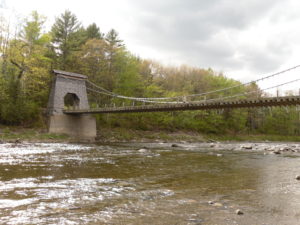
It has been said that Maine received its name due to the large number of islands that dot its coast, making its moniker a truncated version of “Main Land”. And what this land is primarily known for are pine trees, lighthouses, and lobster. Tucked way up in the northeast corner of the country, the area offers some of the most beautiful and scenery in the nation. It is also home to the following five attractions, each located on the – you guessed it – main land.

1. Flagstaff Lake
This lake in the western part of the state covers more than 20,000 acres, with the North Branch Dead River and South Branch Dead River converging here to form the (drumroll, please)… Dead River. The shallow waters (with an average depth of only 18 feet) are often marshy and difficult to navigate by boat, but in order to appreciate the full depth of Flagstaff Lake, it is imperative to know that it began its existence as Flagstaff Village. Named by infamous traitor Benedict Arnold in the early 1800s, Flagstaff Village – along with the neighboring Dead River Plantation – were at one time prosperous towns filled with sawmills and powered by a modest river dam. And, as fate would have it, it would be a dam that would lead to the decimation of these towns.

Back in the mid-1900s, Central Maine Power decided that the most cost-effective means to increase power production within the state was to construct a dam on the Dead River. The construction of this barrier – known as Long Falls Dam – meant literally wiping Flagstaff Village and Dead River Plantation off the map. While many accepted compensation deals from the power company, others resisted, watching their homes slowly disappear beneath the murk as the dam was erected. It has been said that the foundations of many of these homes can be seen beneath the surface of the water on clear days, while ghastly tales often circulate of residents who may have never left these deluged dwellings.

2. Old Fort Western
Constructed in 1754 by the Kennebec Proprietors, this colonial outpost was used to ferry supplies from Boston up the river to Fort Halifax, seventeen miles upstream. The founding of the fort was seen as a strategic political maneuver to exert British influence within the area and wrest power away from the local tribes and French Canadians. However, the site served as a fortified trading post, rather than a military base. Though, like Flagstaff Village above, Fort Western coincidentally has ties to Benedict Arnold, who utilized the post to finalize preparations for an attack on Quebec during the American Revolution.

These days, this National Historic Landmark (and the oldest remaining wooden fort in the country) plays host to a variety of activities, including cannon and musket firing demonstrations, performances of 18th-century military music, and war reenactments. Summer youth programs also offer children a chance to experience what life was like in the 1700s by teaching them about various trades skills of the period as well as how the settlers kept themselves (and their young’ uns) entertained.

3. The Last Wire Bridge
This bridge in western Maine spans across the Carrabassett River, and was one of four such suspension bridges erected within the state during the 1860s. With granite towers marking each end and a wooden plank bed joining one side to the other, the impressive structure is supported by wires and is the last remaining bridge of its kind within the state and, possibly, the country. As such, it has become a bit of a landmark for the small town of New Portland, which boasts a population of just over 700.

This unique overpass was added to the National Register of Historic Places in 1970, and features the original cables from its construction in 1866 (though the timber planks have been restored). Visitors are welcome to traverse the bridge – which is located a short distance from the center of the village – by foot or bicycle, though posted signs warn cyclists to walk their conveyances across.
4. Wild Blueberry Land
Northeast of the Cranberry Isles, in the shadow of Cadillac Mountain, lies a rich, lush land of sprawling fields of…blue?! That’s right. On his 220-acre Wild Wescogus Berries farm, farmer (in the?) Dell Emerson lovingly cultivates the blueberries used in the recipes offered up at Wild Blueberry Land, a tiny “theme park” he and wife Marie have dedicated to the delectable fruit. Guests enter through a geodesic dome – its bright blue coloring often blending into the background skyscape on a clear day – to be greeted by the aromas of Marie’s baked goods featuring their favorite fruit. Some of the most popular items include breads, pastries, and (of course) pies.

From here, guests can explore the seven-acre spread, with the highlight of the attractions being a miniature golf course celebrating the blueberry and including such obstacles as a giant pie baked into an old satellite dish. With Wild Blueberry Land, the Emersons hope to inform the masses on the benefits of small family farming and the preservation of our environment. As a former researcher at the University of Maine – home to the only wild blueberry research farm in the country – it is a subject near and dear to Dell’s heart, which is why the park also offers a youth program geared toward educating youngsters about agricultural practices.

5. Fawcett’s Antique Toy and Art Museum
Founded by John Fawcett, this toy museum and art gallery is dedicated to toys and images that evoke memories of yesteryear. The site features a veritable cornucopia of pop culture-related trinkets, from tin toys and lunchboxes to puppets and train sets. Fawcett, himself an artist, portrays a particular bent for Disney characters in his original works, which are proudly displayed in his gallery. The museum – which was born out of its founder’s vast personal collection of cartoon memorabilia – has been in operation for over 20 years and specializes in buying, selling, and appraising antique toys. Though (well-behaved) children are welcome, the shop is geared more toward adults who will appreciate the craftsmanship and aesthetics of the pieces housed therein.




